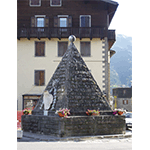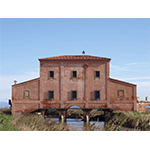The places of Leonardo Ximenes

Born at Trapani in 1716, the Jesuit priest Leonardo Ximenes was one of the outstanding scientific figures in Tuscany under the Lorraines. His interest ranged over many disciplines, from astronomy to physics, from engineering to hydraulics. His extraordinary, eclectic personality was expressed in numerous works, some of which, still visible, possess indubitable scientific fascination and can form the stages of an interesting "biographical" itinerary on science and technology in the 18th century.
Contribution to astronomy
In 1756 Ximenes founded, in the monastery of San Giovannino, a small astronomical observatory, the first in the city of Florence. At the death of the scientist (1786), in accordance with the directions of his will, two chairs were instituted, one of astronomy, the other in hydraulics ,which, remaining active until the middle of the 19th century, clearly expressed the vastness of the Jesuit scientist's interests. In 1757 he published a volume, Del vecchio e nuovo Gnomone fiorentino [Concerning the old and the new Florentine gnomon] (Florence, Stamperia Imperiale), in which he also wrote an interesting compendium of the history of astronomy in Tuscany. He restored the great gnomon in the Dome of Santa Maria del Fiore, which he utilised to conduct a series of astronomical and physical experiments of great importance, and installed the meridian line in the floor of the Cathedral's transept of the Cross.

Designer of bridges and roads
In the second half of the 18th century Ximenes directed the work for the Royal Pistoiese Road, which connected the Grand Duchy of Tuscany with the Duchy of Modena. The infrastructure represented one of the boldest construction projects of the 18th century in Tuscany. Along the road Ximenes designed two bridges over the Lima and Sestaione torrents. In commemoration of this imposing work, Ximenes erected at Abetone, the old boundary line between the Grand Duchy of Tuscany and the Duchy of Modena, two pyramids, still perfectly conserved today.

The great land reclamation projects
For many years Ximenes conducted surveys and assessments in the major swamplands of Tuscany. He studied the hydrological situation of the Massaciuccoli Lake and that of the lake-marshes of Bientina, where he built slice-gates along the course of the old imperial canal. But his best results in this field were achieved in Maremma, around the lake of Castiglione della Pescaia, where the imposing Red House bears testimony to the water system he devised; later known as the Ximenes House, it is now the seat of an interesting multimedia museum. Ximenes was responsible for the first great work of land reclamation in the area, in which canals were dug to facilitate draining water from the lake-swamp into the sea. At Castiglione he also built an aqueduct, of which traces still remain scattered over the territory.
-
 Aqueduct of Castiglione della Pescaia
Aqueduct of Castiglione della Pescaia -
 Bonifica del Lago di Castiglione - Chiusa sul Canale San Leopoldo [Reclamation of Castiglione Lake - Sluice on the San Leopoldo Canal]
Bonifica del Lago di Castiglione - Chiusa sul Canale San Leopoldo [Reclamation of Castiglione Lake - Sluice on the San Leopoldo Canal] -
 Lake Massaciuccoli
Lake Massaciuccoli -
 Leonardo Ximenes' Floodgates
Leonardo Ximenes' Floodgates -
 Museo Multimediale - Casa Rossa Ximenes [Ximenes House - 'Casa Rossa' Multimedia Museum]
Museo Multimediale - Casa Rossa Ximenes [Ximenes House - 'Casa Rossa' Multimedia Museum] -
 The former Lake of Bientina
The former Lake of Bientina -
 Land Reclamation by Leonardo Ximenes (italian only)
Land Reclamation by Leonardo Ximenes (italian only)
****************************
Texts by Graziano Magrini
English translation by Catherine Frost
Last update 05/mar/2008


